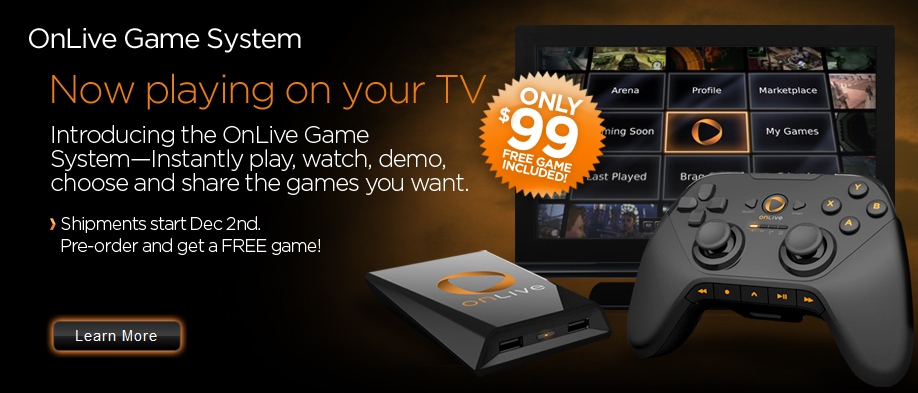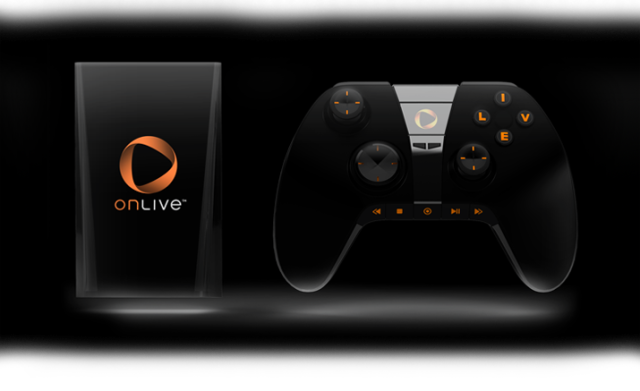OnLive Service and Micro-Console Review (December 2010)
By Saieno 44 Comments
OnLive is a completely free games on demand service that allows you to play high-end titles on low-end PCs and Macs. On December 2nd, OnLive started shipping the OnLive Micro-Console to give customers with HDTVs a chance to play in their living rooms.
Service
OnLive was created by Steve Perlman, who also created QuickTime, MSN TV, and MOVA. The service first launched to the public in June 2010, but was met with much skepticism in regards to ownership, the monthly fee, and other requirements at the time. If you tried out the service back in June, odds are you haven't checked in to see how its doing. In the last 6 months OnLive has recieved some major improvements and is definately worth checking out again. The monthly fee has since been dropped, more titles and a back catalog has been added, video clarity and performance has improved, and the micro-console has released. Download it, try it out, you'll be amazed if you stop for a moment and realize its not running on your computer at all.Features
The OnLive Micro-Console has support for 1080p video, 5.1 surround sound, stereoscopic 3D, four controllers, and four bluetooth headsets. At the time of this review the micro-console supports 1080p though the games are upscaled from 720p. 1080p gaming should be available by next year, along with voice chat. I was told that the 5.1 surround sound wasn't currently implemented, however when I connected my surround sound headset into the micro-console the surround sound worked perfectly.
The Wireless Controller is probably the most impressive part of the hardware, sporting a very comfortable design, hefty balance, smart button layout, and convienent media bar along the bottom. The triggers have a very natural pressure to them, and the shoulder buttons are easy to get to without getting in the way. The D-Pad is very nicely designed, making it perfect for fighting games and exact movements. Overall the Wireless Controller is probably the best controller I've ever owned, and I can't wait until PC support is implemented for it.
Multiplayer in OnLive is unique compared to other consoles. Unlike other games you play online where you can see players jittering around on the screen, people using hacks and exploits, and other latency related issues, OnLive is completely devoid of these things. OnLive is basically run like a giant LAN network, so when you're spectating someone or playing a multiplayer game with them, there is no latency/lag/pause/jitter. It is instantaneous. What they see is EXACTLY what you see.
Bandwidth
OnLive has a minimum requirement of 1.5Mb/s, though 3Mb/s is reccomended and 5Mb/s is preferred. The problem is when people hear these numbers, majority of the time they assume they don't meet the minimum requirements. You can give OnLive a try on your PC or Mac for free to see how it performs for you. What's great about the micro-console is it takes less bandwidth than your PC or Mac does. Depending on your TV size you'll require a different amount of bandwidth. 52" is 5Mb/s, 42" is 4Mb/s, 32" is 3Mb/s etc. So it's safe to assume that if you have a 22" TV that you'll need 2Mb/s, that's the idea anyway.Now what about bandwidth caps. Comcast for example has a 250GB bandwidth cap which would give you approximately 150 to 300 hours of gameplay a month, depending on what you're doing on the service. Some companies have limits as low as 60GB a month, and if this is similar to what you have then OnLive probably won't work out well for you with that ISP.
Lag
When talking about OnLive you have two forms of lag, internet performance and game performance. Internet performance can become an issue if your connection isn't stable and contains jitter, but unfortunately this is out of OnLives hands for the most part. OnLive has partnered with many ISPs to re-route your connection to give you the best experience possible, but if your connection is jittery or your ISP isn't giving you the connection you're paying for, then you might want to give them a call to check the lines.As far as game performance goes it is pretty much on par with other consoles. Very few games dip below 30 FPS, with majority of them performing at a solid 45 to 60 FPS. The only game I've had performance issues in is Just Cause 2, problem being the controls feel sluggish. I don't think this is a fault of OnLive, when I tried Just Cause 2 on my PC I had a similar issue.
Games
Jumping into a game and playing instantly couldn't be easier or more gratifying. For each game you have the option of playing a trial, renting for a few days, or purchasing the full title. The current game selection is around 35 titles right now, though they hope to have around 50 or 60 games by the end of the year. When the micro-console launched they launched the PlayPack Beta alongside it, giving early adopters of the micro-console access to 14 back-catalog games. Once the PlayPack service launches on January 14th, they expect to have around 40 titles.They also have another 100 titles, including Driver: San Francisco, Deus Ex: Human Revolution, Ghost Recon: Future Soldier, FEAR 3, Duke Nukem Forever and Assassin's Creed: Brotherhood, currently in development for release in 2011, many of which are day-in-date with console releases. Still for a new console launch it has more games than Xbox 360 and PlayStation 3 launched with. There are no exclusive titles yet of course, but given time I'm sure we'll see some interesting software come to OnLive.
Video Quality
There are two video streams that OnLive uses while a game is being played. One is the media stream, which is used when spectating someone or when a brag clip is taken. This stream is usually lower in quality, more akin to a YouTube video. The second stream is the gaming stream, which is used when you're actually playing a game. The gaming stream is optimized for playing the game and looks crisp and clear. Of course you may see some compression if you look for it or take a screenshot, but OnLive is made to look great in motion and not in a still frame.When I sat an uncomfortbale distance from my screen (about a foot or so) I could see compression, however when I sat back and relaxed to just enjoy the games (about three feet away) I didn't notice any compression at all. When playing on a PC or Mac with a resolution of 1920x1080 OnLive might not look as good, since the image is being scaled up and causes blurring. You're also sitting much closer to a monitor than you would a TV, so compression will be much more noticeable.
Pricing
The OnLive Service is free to use on the PC and Mac, while the Micro-Console costs $99. What do you get with this $99? As shown when I unboxed it, you get the micro-console itself (never has to be upgraded), an extremely high-quality wireless controller, HDMI Cable, Ethernet Cable, and a Promo Code good for any game on the service (e-mailed 24-48 hours after your order ships). With Xbox 360 and Playstation 3 currently priced between $299 and $399, if you're just looking to play games and enjoy them with your friends, $99 is a much smaller pill to swallow.As far as prices for the games, everything seems fairly priced for what you're getting. New releases are usually $10-$20 below other console release prices, while other games are usually half the price that you'd find in stores. Some games are similarly priced when compared to stores, but these titles on OnLive contain extra addon content that don't come with the retail versions. Then there's the optional PlayPack Back-Catalog which gives you access to 40 games for $10 dollars a month. At what is esstentially 25cents a game this is an awesome deal, and gives gamers tons of great titles for a very small fee.
Pros
Travels with you - If you start a game on your Micro-Console and someone needs the TV, you can continue it on your PC. If your friend wants you to come hang out at their house, bring your Laptop and finish the game there.
Same Experience Across Devices - Whether you play OnLive on PC, Mac, or the Micro-Console, you're getting the same experience. If you have to spend some time at a relatives it doesn't matter if they have an E-Machine, you'll have your games, saves, and friends all there with you.
No Physical Media or Hardware - I personally loathe carrying around boxes of games I don't play anymore, or storing disks in binders. Then if I buy I game I need to make sure my computer meets the requirements. If I have a 360 or PS3, then I need to hope my system doesn't Red Ring or Yellow Light. OnLive puts the focus back on the games instead of the hardware.
Affordable - OnLive allows for all kinds of budgets, from trials and rentals to full playpasses and subscriptions. And for everything you get with the $99 Microconsole, its a steal.
Never Needs Upgrading - OnLive updates their hardware every 6 months, which means I never have to worry about upgrading again. When the next-gen consoles and games come out, OnLive will run them without any additional costs or requirements.
No Downloads or Installs - With OnLive I don't have to wait for downloads or installs, I just choose the game and go. For things like addon packs for games like Borderlands, you simply buy them and jump right back in to enjoy the content.
Instant Play - If you see something that interests you, just click play and you're there. Hopping between games is much like changing channels, and makes short play sessions a breeze.
Cons
No Physical Copy - With OnLive everything is digital, so you won't have any physical copies of the game. Usually collectors worry about physical copies, since I'm not a collector it doesn't bother me much.Dependant on Internet - If the internet goes down, so does your gaming. For many, relying on something so unreliable might not be worth investing in.
Bandwidth Limitations - If you're on a connection with a bandwidth limitation, then you're going to hit the cap pretty quickly with OnLive.
I know there are more pros than cons in this list, but the cons are much more impacting on the service than the pros are. My apologies for not coming up with more, but I want to base the review on the service as it is currently and not what I think it should be.










Log in to comment